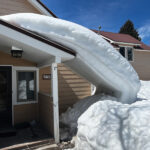End flare can be inherent in roll formed parts, especially when produced on a precut roll forming line as opposed to a post-cut line that forms the panel first and then shears it to length.
Producing roll formed roof and wall panels with tighter tolerances and less flare

The amount of flare depends on the tooling design, the use of anti-flare fixtures, material type and strength, profile or a combination of these factors. Excessive end flare in roll formed shapes can cause issues when installing and end lapping panels. Purlins used in rigid building structures are heavy gauge and deep sections can have more end flare.
Forming a Purlin
When forming a purlin, it will naturally flare in on the leading edge and out on the trailing edge. In other words, the leg angles on the leading edge are typically over 90 degrees, while the trailing edge leg angles are less than 90 degrees. The return lips can also have flare making it difficult when face-to-face welding cee sections. Just a few degrees of end flare on an eave strut can cause a high spot in the roof panel that is fastened to this section.
To minimize and control flare in purlins, a typical anti-flare fixture is incorporated into the straightener at the end of the machine. Both the drive and operator side have a three-roll configuration to independently control the flare on either side of the part. The position of the center roll must satisfy both the leading and trailing flare. This can be a balancing act, due to a single adjustment affecting both. With that said, operators will typically find that middle ground on the center roll adjustment that adequately reduces the flare on the leading and trailing ends to within tolerance.
Servo driven auto anti-flare fixtures are different to stationary anti-flares on the straightener fixture. They are designed to adjust for leading and trailing flare, drive side and operator side independently and doing it all on the fly. This adjustment is defined by the operator and stored in the control for each specific part size, profile and thickness. This provides increased repeatability along with more control and less operator setup time.
Auto anti-flares are able to achieve a leg angle tolerance of plus/minus 1 degree. Roof and wall panel lines sometimes require flare fixtures. The flare can be more apparent in taller rib roof panels. In such cases a three or four roll flare fixture is used. It works in a similar manner as the purlin parts by breaking the leading or trailing edge of the part around rolls positioned in critical locations to get the desired results.
Adjustments, Advancements
Shallow profile panels don’t typically require flare fixtures. When flare or taper is a problem, adjustments are made to the stands in critical passes. By increasing or decreasing the tooling gaps in critical passes, like overform passes, and passes prior to overform passes, the operator can have a tremendous effect on reducing flare, or taper in the panel.
With the advancements in control technology and developments in roll tooling designs, manufacturers are able to produce roll formed parts such as roof and wall panels, and cee and zee purlins with tighter tolerances and less flare than ever before.
Matt Werner is sales and marketing manager at The Bradbury Group, Moundridge, Kan. For more information, visit www.bradburygroup.com or email matwer@bradburyco.com.







